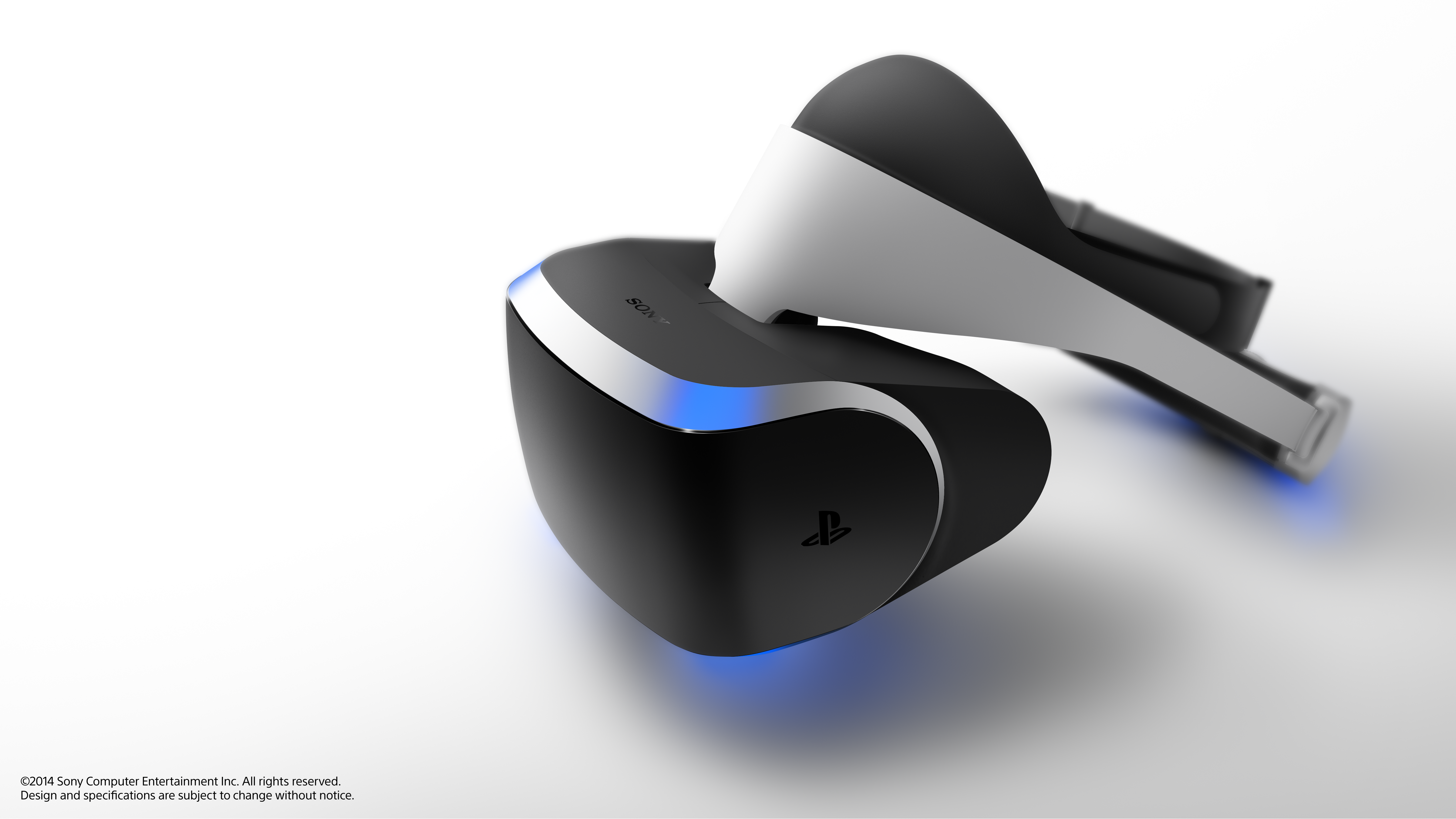The Past, Present, And Future Of VR And AR: The Pioneers Speak
Sony Morpheus
VR and AR are the next exciting frontiers in gaming, and most of the innovators are startups. Then, at GDC 2014, Sony took the wraps off Project Morpheus, a VR solution for the PS4 console. In our limited time with Project Morpheus, we found it remarkably similar in experience to the Oculus Rift, and there's nothing wrong with that. Project Morpheus is aimed squarely at the PS4 console gamer, while all the other players are working on PC or mobile solutions. There's plenty of room for everyone in this exciting new gaming space, and ultimately it's the gamer who wins the more popular VR becomes.
Richard Marks, Sony's senior director of software engineering provided the answers below.
| "Project Morpheus" Prototype Specs | |
|---|---|
| Component | Processor unit, head-mounted unit |
| Display Method | LCD |
| Panel Size | 5 inches |
| Panel Resolution | 1920×RGB×1080 (960×RGB×1080 per eye) |
| Field of View | 90 degrees |
| Sensors | Accelerometer, Gyroscope |
| Connection interface | HDMI + USB |
| Function | 3D audio, Social Screen |
*Specifications and designs are those of the prototype and are subject to change.
Tom's Hardware: Is your technology based on AR or VR, and why?
Sony: Project Morpheus is a VR system. AR is generally defined as real-time mixing of graphics with real-world imagery, whereas VR is graphics-only (like traditional games). The goals of AR and VR are typically very different. With Project Morpheus, our goal is to create virtual environments and make it feel as if you are present in a different place (i.e. VR), rather than augment the space you are actually in (i.e. AR), which you can experience on PS4 with the Playroom.
Tom's Hardware: When will we see mass adoption of VR or AR technology (defined as more than one million customers)?
Sony: We believe there is great interest in the experience of VR and after announcing Project Morpheus at GDC in March we have received many positive responses from developers, gamers, and the VR crowd. For many products, a high-value combination of hardware and content is needed to achieve mass adoption. Our intent with Project Morpheus is to provide such a combination, which we expect to be able to do when a consumer version is ready to launch in the future. The prototype we currently are working with will continue to improve but we’re excited that developers will get to experiment with creating VR games and look forward to what Morpheus will bring in the future.
Get Tom's Hardware's best news and in-depth reviews, straight to your inbox.
Tom's Hardware: What are the technical hurdles still standing in the way?
Sony: At this point, there are no fundamental technical hurdles, but good engineering is needed to create a good product. As we outlined in our presentation about Morpheus at GDC, the key technical areas we are focusing on are Sight, Sound, Tracking, and Control, which are critical components in VR becoming a success. We need to mimic the two primary human senses, sight and sound, with high-fidelity while also placing consumers in a virtual world that responds quickly and accurately to movement. These key areas will help achieve presence, where you feel like you’ve been placed into another world. This is the ultimate experience we are working so hard to bring to VR.
Tom's Hardware: What are the non-technical hurdles standing in the way?
Sony: For mass adoption, just like for all consumer electronics products, we know ease of use is critical. Ergonomics, simplicity, and reduced encumbrance are key areas. PlayStation has always been dedicated to making games accessible to everyone. With Project Morpheus, we’re aiming to make it as straightforward as possible -- gamers simply connect the VR headset to their PS4 and start a game. And as we know from our console experience, good content is really the key to widespread adoption. To that end, we’re focused on ensuring a smooth development process for game creators, and unveiling Project Morpheus early on for developers at GDC was a big part of that approach.
Tom's Hardware: What steps are needed to remove those hurdles? What is your company doing specifically and technically to remove those hurdles?
Sony: We built and announced the devkit for Project Morpheus at GDC so that developers can get started creating content immediately. We believe the devkit is a good platform for the developers to experiment with and send us feedback while our engineering teams continue to refine the Morpheus hardware. It’s been over three years since we first began this project at PlayStation and while we've made incredible strides with Morpheus, we are dedicated to bringing the best VR experience to consumers.
Tom's Hardware: How will VR and AR change the gaming ecosystems in the future (PCs and components, consoles, controllers, and the games themselves)?
Sony: VR is a much more immersive experience than traditional console games. We believe Morpheus will expand the PlayStation ecosystem as another medium for publishers and developers to create content. VR will also create a new market for fundamentally different experiences that don't exist today. We also believe VR will expand the market for video games rather than replace the existing market.
Tom's Hardware: How will VR and AR change the world outside of gaming? Give us the most remarkable, life-changing examples you expect to happen?
Sony: The key experience enabled by VR is the feeling of actually being present in another place, either real or fictional. Our initial focus for this technology will be new gaming experiences, which will be huge, but we expect the impact of VR will extend well beyond games. Just visiting a favorite place, again either real or fictional, is extremely compelling—basically, virtual tourism. It is hard to convey with words to someone who hasn’t experienced it, but I like to use the analogy that VR is to video, as video is to a still image. VR is that much richer of an experience than just seeing a movie.
Eventually, I expect you will be able to be sitting in your family room, pick your VR headset up off the coffee table, and immediately be "present" somewhere else. There are many other useful applications for this, such as real estate, or for virtually visiting a place to get more acquainted with a destination before you actually visit, or even deciding which hotel you might want to book. One non-gaming experience I personally have worked on uses real data of the Mars surface gathered by the NASA/JPL rover Curiosity. We created an experience that lets you virtually "visit Mars" and stand next to the Curiosity rover, something most of us are unlikely to ever do. And with VR, you could virtually visit even more exotic locations than Mars, such as Hogwarts or "The Wall" of Westeros.
Read more: Project Morpheus vs. Oculus Rift Development Kit 2
Current page: Sony Morpheus
Prev Page Oculus VR Historical Timeline Next Page Vuzix Corporation M100-
icepick314 would Virtual Boy from Nintendo count as VR tech?Reply
it's missing in the article's timeline...
also an arcade game Time Traveler that had "holographic" screen... -
Cazalan I think they're wasting too much time on the motion capturing aspect. Just give me a headset that looks better than a 30" monitor and I'm sold.Reply -
Vlad Rose With the Virtual Boy, I would call it VR tech as it uses similar technology that used in the VR gear that is coming out. With Time Traveler and Holosseum, I would say no. What they used was a single 2D screen that was projected to a curved mirror to create a false reality of the image 'sticking out'. It is more comparable to 3D movies than Virtual Reality.Reply -
clonazepam The Vuzix seems pretty cool. We've already accepted bluetooth headsets and its a very similar look. I hope they all account for the fact that some people are right-handed and left-eye dominant or other way around, as well as color blind or red / green deficient.Reply
I think the Vuxio would be the most useful in everyday life, while obviously Oculus or Morpheus being the most fun. -
Shankovich Morpheus looks cool but it just can't compete with the rift when hooked up to the PS4; it just doesn't have the graphical power to run above 1080P games with acceptable level of detail, effects, etc. especially when the frame rate will need to be at 60fps or more to reduce nauseating effects. On PC, the rift has better sensors (geomagnetic) and is better able to take care of movement lag.Reply -
CaedenV @CazalanReply
Agreed. I am all for VR to hit when it is really ready, but until then I would be extremely happy with a high resolution headset to use as an immersive display. I don't want to have to crane my neck and change my body's orientation when gaming. I still want a keyboard/mouse or controller as input and be able to sit back on the couch and just play a game. I have a nice big yard to work on if I want something active to do... when I am gaming I want to get into it, but with the least amount of physical effort possible. -
Henderburn The VR timeline should include the release of "Snow Crash," the novel that inspired John Carmack and Michael Abrash to make Quake and build the foundations for VRReply -
WyomingKnott I'm still waiting for a decent eyeglass-size display so I can read a book while the dentist pokes at my teeth. Seriously, we don't have even the basic display element available commercially?Reply -
Cybolic Vuzix examples are probably the worst I've ever heard: "having a sales associate be able to answer your questions" and "see exactly where your veins are so they only stick you once with the needle to get the blood", yeah, they are supposed to already be able to do that without wearing special glasses; it's literally what they're being paid for.Reply

